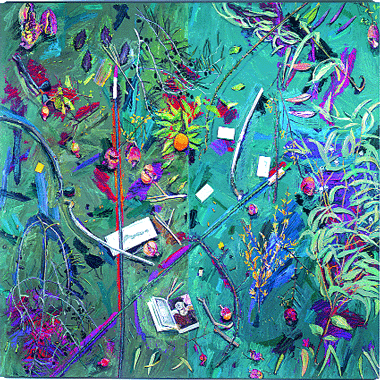Film critic, essayist Manny Farber offers painting worthy of contemplation at P.S. 1
With the dumbing down of contemporary culture, one of the trickle-down effects of the Republican ascendancy has been the capitulation of cultural institutions. I am thinking primarily of the Brooklyn Museum, which has become the equivalent of your Local Oldsmobile Dealer, doing whatever is necessary to get you into the meet-and-greet area of its new Polshek entryway, which does look suspiciously like an auto showroom.
The Brooklyn Museum had a history as a serious place when it came to contemporary and modern art, taking shows that were a little ahead of their time or slightly offbeat like the Gordon Matta-Clark retrospective, the Sigmar Polke exhibition, Mariko Mori and the very odd, thrilling Gustave Courbet exhibition, which included the iconic “Origin of the World,” the most contemporary of all 19th century paintings. Except for Mori, these shows all took place more than ten years ago.
I doubt that this museum will be this interesting again by the looks of things. Happily, P.S.1 in Queens is not caving into popularizing pressure; it always seems to be full of Europeans, who don’t seem to feel the same need for Entertainment Art. The exhibition history of P.S.1 has been exemplary, though not always well-covered by the press. Recent high points include the exceptional Kim Sooja video installation, the John Wesley retrospective and the survey of Italian Minimalism of the 1960s. I was also impressed and rewarded by the collection of the filmmaker Jack Smith’s costumes, notes, drawings and ephemera, the self-portrait photographs of John Coplans and, most recently, the roundly ignored Lee Lozano show. The Lozano exhibition, if nothing else, demonstrated what sexually gritty work looks like before it passes through the Starbucks filter of corporate culture and becomes Carroll Dunham’s paintings.
More inspiring is Manny Farber, the flinty genius writer and film critic whose paintings are currently on display at P. S.1. “Negative Space,” a book of his collected film criticism, contains the famous essay “White Elephant Art vs. Termite Art”, the best five pages on the practice of artmaking written in the past 50 years. Read it and re-think the work of Chuck Close, Bruce Nauman and the practitioners of what has become known as the Williamsburg International Style.
In the October issue of Art in America, Farber, in an interview, credits his wife as a full collaborator in the essays and paintings but he is given solo credit in the show. The paintings resist fast consumption; the eye has to slowly make its way through the rendered figs, sunflowers, clipboards, post-it notes, gardening tools, fish heads, nuts, mushrooms, crabs, scythes, rebar, open art books, leeks, plates of fruit, flower arrangements, tea towels, candles, peasant breads and numerous other objects that populate his painted tabletop still-lifes.
The early paintings utilize candy bars, their graphic lettering enlivening the pictures much the way that Farber’s hero, Jean-Luc Godard, imposed text messages in the plane of the film screen. As Farber’s work progresses, the knifings, hatchings and scrawls complexify the surface as the objects painted become more baroque and the paths through the arrangements become deeper. The color is rich, acidic and bracing. Farber—or his wife, Patricia Patterson, perhaps—favors rich blues, vibrant purples and stiff light browns. This generous art rewards the viewer with the slow comprehension of a mind a work.


































